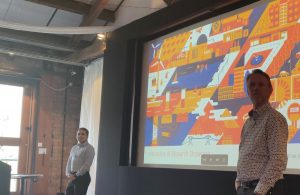This blog post is written by CDT Student Matt Clifford
The second day of the research showcase focused on the future of interactive AI. This, of course, is a challenging task to predict, so the day was spent highlighting three key areas: AI in green/sustainable technologies, AI in education and AI in creativity.
Addressing each of the three areas, we were given introductory talks from industry/academia.
AI in green/sustainable technologies, Dr. Henk Muller, XMOS
Henk is CTO of Bristol based micro chip designers XMOS. XMOS’s vision is to provide low power solutions that enable AI to be deployed onto edge systems rather than being cloud based.
Edge devices benefit from lower latency and cost as well as facilitating a more private system since all computation is executed locally. However, edge devices have limited power and memory capabilities. This restricts the complexity of models that can be used. Models have to be either reduced in size or precision to conform to the compute requirements. For me, I see this as a positive for model design and implementation. Many machine learning engineers quote Occam’s razor as a philosophical pillar to design. But in practice it is far too tempting to throw power-hungry supercomputer resources at problems where perhaps they aren’t needed.
It’s refreshing to see the type of constraints that XMOS’s chips present us with opening the doors for green and sustainable AI research and innovation in a way that many other hardware manufacturers don’t encourage.
AI in Education, Dr. Niall Twomey, Kidsloop

AI for/in/with education helps teachers by providing the potential for personalised assistants in a classroom environment. They would give aid to students when the teacher’s focus and attention is elsewhere.
The most recent work from kidsloop addresses the needs of neurodivergent students, concentrating on making learning more appropriate to innate ability rather than neurotypical standards. There is potential for the AI in education to reduce biases towards neurotypical students in the education system, with a more dynamic method of teaching that scales well to larger classroom sizes. I think that these prospects are crucial in the battle to reduce stigma and overcome challenges associated with neurodivergent students.
You can find the details of the methods used in their paper: Equitable Ability Estimation in Neurodivergent Student Populations with Zero-Inflated Learner Models, Niall Twomey et al., 2022. https://arxiv.org/abs/2203.10170
It’s worth mentioning that kidsloop will be looking for a research intern soon. So, if you are interested in this exciting area of AI then keep your eyes peeled for the announcements.
AI in Creativity, Prof. Atau Tanaka, University of Bristol

The third and final topic of the day was Ai in a creative environment, specifically for music. Atau showcased an instrument he designed which uses electrical signals produced by the body’s muscles to capture a person’s gesture as the input. He assigns each gesture input to a corresponding sound. From here a regression model is fitted, enabling the interpolation between each gesture. This allows novel sounds to be synthesised with new gestures. The sounds themselves are experimental, dissonant, and distant from the original input sounds, yet Atau seems to have control and intent over the whole process.
The interactive ML training process Atau uses glimpses at the tangibility of ML that we rarely get to experiment with. I would love to see an active learning style component to the learning algorithm that would solidify the human and machine interaction further.
Creativity and technology are intertwined at their core and I am always excited to see how emerging technologies can influence creativity and how creatives find ways to redefine creativity with technology.
Breakout Groups and Plenary Discussion

After lunch we split into three groups to share thoughts on our favourite topic area. It was great to share opinions and motivations amongst one another. The overall drive for discussion was to flesh out a rough idea that could be taken forward as a research project with motivations, goals, deliverables etc. A great exercise for us first years to undertake before we enter the research phase of the CDT!
Closing Thoughts
I look forward to having more of these workshop sessions in the future as the restrictions of the covid pandemic ease. I personally find them highly inspirational, and I believe that the upcoming fourth IAI CDT cohort will be able to benefit significantly from having more in person events like these workshops. I think that they will be especially beneficial for exploring, formulating and collaborating on summer project ideas, which is arguably one of the most pivotal aspects of the CDT.



